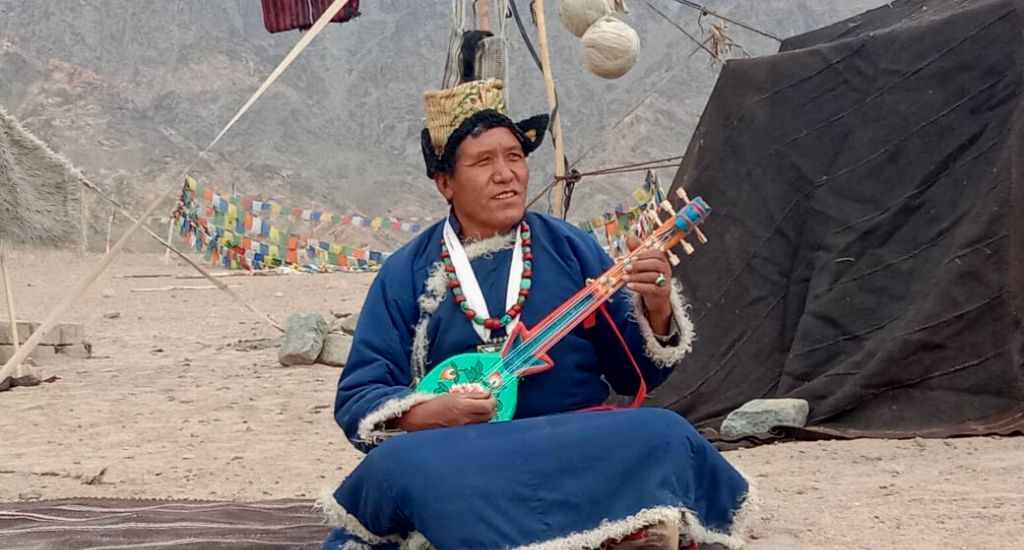
Ladakh’s lute maker gives ‘dranyen’ new lease of life
Leh-based craftsman Tsering Angchuk helps to revive six-stringed slender musical instrument that once was synonymous with the nomads of the highlands of Jangthan Kharnak.

Leh-based craftsman Tsering Angchuk helps to revive six-stringed slender musical instrument that once was synonymous with the nomads of the highlands of Jangthan Kharnak.
Tsering Angchuk remembers growing up to the sweet sound of the dainty six-stringed lute, locally called the dranyen.
In the highlands of Jangthang Kharnak – a harsh but pristine region high up in the Himalayas more than a 100 km from Ladakh’s capital Leh – the dranyen was a way of life.
But that was then, during the growing up years of Angchuk.
Much has changed since then.
Angchuk has grown older and is 55 now. Many consider the dranyen too as old-fashioned.
It meant that the long-necked instrument with a double-waist usually carved out of a single piece of wood had ceased to be in demand.

In more ways than one, the declining popularity of the dranyen also showcased how life for the community in the eastern part of Ladakh has undergone a fast transformation.
Earlier, nomads of the region, who had a lot in common with the people, customs and tradition of Tibet, would play the dranyen and sing folk songs while they herded their flock.
The know-how of making the instrument dates back to the 17th century and originates from the western part of Tibet called Ngari.
But much of the pastoral land has vanished with the advent of the Indian army and assorted development projects following the 1962 Sino-Indian war.
Some 70% of the local people – the Kharnakpas – migrated through the 1990s to Leh for better livelihood prospects.

Angchuk too moved to Leh when he was 20. Besides struggling to make a living, he missed his home and longed for its way of life.
Then an idea struck.
Always good at wood craft, Angchuk carved out a dranyen in double quick time.
The instrument hit the right notes, intoxicating Angchuk. He made more dranyens.
Thanks to him, the dranyen, which had somehow fallen to disuse, has somewhat got a fresh lease of life.
“Dra refers to tune and nyen means melody – the instrument that produces touching tunes.
Its physical shape may vary across the Tibetan plateau and the Himalayas. In Ladakh, it comes mainly with horse-head,” Angchuk pointed out.
Angchuk has not stopped making new dranyens. The wood from the willow tree is the preferred choice in giving it shape.

“The thicker the wood, the better the sound. It normally takes 3-4 days to make a complete lute,” he said.
It is hard work. But his persistence has begun to pay off.
Initially, there was no demand and he would pass time playing the unsold instruments himself.
Now, he sells 40-50 lutes a year, each costing between Rs 6,500 and Rs 8,000.
The state administration has done its bit in promoting the dranyen. Angchuk and his friends were invited to perform by the Leh station of All India Radio.
He has also travelled to states such as Rajasthan and Madhya Pradesh to perform. In between, he visited Prague for a performance.
“As a musician and craftsman, I am proud to say that dranyen is the only handmade and locally produced instrument in Ladakh. Even daman (drums) and surna (oboe) are procured from outside Ladakh,” Angchuk said.
The musical landscape of Ladakh has changed since the reappearance of dranyen in the market.

The youth, schools and various institutions are buying in bulk to learn the instrument. Its fame spreading, Angchuk has sold 400 dranyens.
Apart from the profits, the revival of dranyens is generating quite a bit of praise too.
“I am reconnecting to my roots and culture through a folk instrument like dranyen. Never had my generation got an opportunity to learn this auspicious instrument because of its unavailability,” said Jigmat Rabstan, 28, a music teacher at Druk Padma Karpo school.
A long-lost musical tradition of Ladakh is staging a comeback, courtesy Angchuk and his dranyens.
The lead image shows Angchuk playing his handmade lute near a traditional nomadic tent in Jangthang Kharnak (Photo by Dawa Dolma)
Dawa Dolma is a freelance journalist based in Leh. She writes about climate change, communities, and culture of the Himalayas. She is a Rural Media Fellow 2022 at Youth Hub, Village Square.